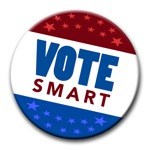 While the blogosphere isn't exactly devoid of political posts, I thought I'd add one with a different twist - a discussion of the mathematical side of voting.
While the blogosphere isn't exactly devoid of political posts, I thought I'd add one with a different twist - a discussion of the mathematical side of voting.
Let's start off with a simpler but nonetheless confounding situation. Imagine a poll of 3 political candidates' popularity is taken. When the results are released, the polls show that 2/3 of voters prefer A to B, and also that 2/3 of voters prefer B to C. Obviously, the voters must definitely prefer A to C, right?
Not necessarily. Surprisingly it is still possible for 2/3 of voters to prefer C to A! In his book, Aha! Gotcha!, Martin Gardner gives a clear example of exactly how this is possible in the section on the Voting Paradox.
The principle causing the apparent contradiction is known as non-transitivity. I've even discussed the idea of employing non-transitivity and politics together, albeit for entertainment, in my Remembering the Election post. While you can find out more about the nature of non-transitivity from Martin Gardner's works, and it will help you understand some of the following discussion, I don't want to veer off the political topic for now.
It's largely non-transitivity that keeps US elections limited to two-party elections, with third-party candidates acting as little more than spoilers. Steven J. Brams, author of Mathematics and Democracy, briefly discusses this in his Plus Magazine article, Mathematics and democracy: Approving a president:
The system used in the US — and many other places, including the UK — is known as plurality voting (PV). PV is based on the "one person, one vote" principle: every citizen casts only one vote for his or her preferred candidate, and the person with most votes wins. But PV has a dismaying flaw: in any race with more than two candidates, PV may elect the candidate least acceptable to the majority of voters. This frequently happens in a three-way contest, when the majority splits its votes between two centrist candidates, enabling a more extreme candidate to defeat both centrists. PV also forces minor-party candidates into the role of spoilers, as was demonstrated in the 2000 US presidential election with the candidacy of Ralph Nader. Nader received only 2.7% of the popular vote, but this percentage was decisive in an extremely close contest between the two major-party candidates.
That whole article is worth reading, especially in relation to alternative voting procedures of which you may never heard, but are nonetheless mathematically valid ways of choosing a leader.
An excellent companion article to this book can be found in Martin Gardner's The Last Recreations, in which he reprints an excellent article in his Voting Mathematics column (this is a limited preview article, so some pages are missing).
Interestingly, the US legal system is already preparing to hear mathematical alternatives to our current voting systems. One of the aspects of the US political system that generates the most discussion for improvement is the Electoral College system, especially where it concerns the division of districts and the potential for Gerrymandering.
Back in 2006, a case concerning congressional redistricting in Texas reached the Supreme Court. Interestingly, Justice Kennedy issued a plea in his opinion for workable standards of congressional redistricting. Unfortunately too late for the Texas court case, mathematician Zeph Landau has proposed a workable idea he says is ready for the next such challenge. While the linked article describes the mathematics in more detail, it's easier to explain it with a recent Jif Peanut Butter ad that uses exactly the same idea. Think of the boys as the two parties, the mom as a third-party member without any stake, and the bread as the state:
Alas, much of this discussion is theoretical for now, as such major changes to the election system would be, by definition, unconstitutional in the US. So, until judges rule such systems to be within constitutional bounds, or an amendment is ratified to change things, we'll unfortunately probably be seeing much of the same for the foreseeable future.




1 Response to Voting and Mathematics
In the UK, we vote for a local representative who is a 'Member of Parliament' (MP). We do not choose the leader because his/her party elects him. eg. Nobody voted for the current Prime Minister.
There is an indirect link between our votes and the elected leader but it is not as direct as the US way of doing things. And, if 10,000 people are enough to elect 1 MP in 1 constituency and 20000 are needed to elect another MP in another constituency then you can get the maths where the Prime Minsiter is elected on less votes .. if you see what I mean.
Here is something I had online a while back to stimulate debate:
http://www.nakedscience.com/other/demicracy.htm
Post a Comment